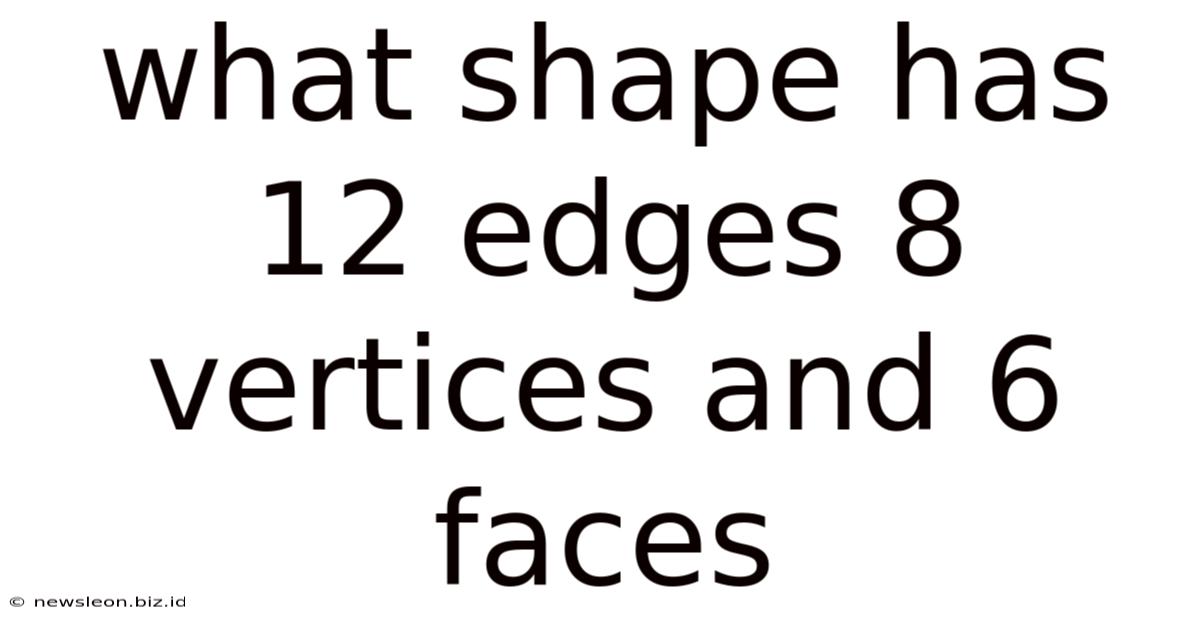What Shape Has 12 Edges 8 Vertices And 6 Faces
News Leon
May 04, 2025 · 5 min read

Table of Contents
What Shape Has 12 Edges, 8 Vertices, and 6 Faces? Unlocking the Geometry of the Cube
Determining a three-dimensional shape based solely on its edges, vertices, and faces might seem like a complex geometrical puzzle. However, with a systematic approach and a little understanding of solid geometry principles, we can easily identify the shape possessing 12 edges, 8 vertices, and 6 faces. This article will delve into the fascinating world of polyhedra, exploring the characteristics of various shapes and ultimately revealing the answer to our question.
Understanding the Fundamentals of Polyhedra
Before we embark on our shape-identifying journey, let's establish a strong foundation in the vocabulary of solid geometry. A polyhedron is a three-dimensional geometric shape composed of flat polygonal faces, straight edges, and sharp vertices (corners). Each face is a polygon, and the edges are where the faces meet. The vertices are the points where three or more edges converge.
Key terms we'll be working with include:
- Faces: The flat polygonal surfaces that make up the shape's exterior.
- Edges: The line segments where two faces intersect.
- Vertices: The points where three or more edges meet.
Euler's Formula, a cornerstone of polyhedral geometry, provides a crucial relationship between the number of faces (F), vertices (V), and edges (E) of any convex polyhedron:
F + V - E = 2
This formula will prove invaluable in our investigation.
Exploring Potential Candidates: Regular and Irregular Polyhedra
Numerous polyhedra exist, each with its unique combination of faces, vertices, and edges. Let's explore some possibilities:
Regular Polyhedra (Platonic Solids)
Regular polyhedra, also known as Platonic solids, are highly symmetrical shapes where all faces are identical regular polygons, and the same number of faces meet at each vertex. There are only five regular polyhedra:
- Tetrahedron: 4 faces, 6 edges, 4 vertices
- Cube: 6 faces, 12 edges, 8 vertices
- Octahedron: 8 faces, 12 edges, 6 vertices
- Dodecahedron: 12 faces, 30 edges, 20 vertices
- Icosahedron: 20 faces, 30 edges, 12 vertices
Immediately, we can see that the cube fits our criteria of 6 faces, 12 edges, and 8 vertices.
Irregular Polyhedra
Irregular polyhedra lack the perfect symmetry of regular polyhedra. Their faces can be polygons of different shapes and sizes, and the number of faces meeting at each vertex can vary. While numerous irregular polyhedra exist, it's important to note that they don't necessarily follow the simple, elegant characteristics of the Platonic solids. We need to check if an irregular polyhedron could match our parameters of 12 edges, 8 vertices, and 6 faces. While theoretically possible, the highly symmetrical nature of this combination strongly suggests a regular polyhedron.
Applying Euler's Formula to Confirm Our Findings
Let's verify our suspicion that the shape is a cube using Euler's formula:
- Faces (F): 6
- Vertices (V): 8
- Edges (E): 12
Substituting these values into Euler's formula:
6 + 8 - 12 = 2
The equation holds true, confirming that the shape with 12 edges, 8 vertices, and 6 faces indeed satisfies the fundamental geometric relationship for convex polyhedra.
The Cube: A Closer Look at its Properties
The cube, also known as a hexahedron, is a three-dimensional solid with six square faces, twelve edges, and eight vertices. Each face is a square, and three squares meet at each vertex. It possesses remarkable symmetry, with rotational symmetry about each of its axes.
Properties of a Cube:
- Faces: 6 square faces
- Edges: 12 edges of equal length
- Vertices: 8 vertices
- Diagonals: 4 space diagonals connecting opposite vertices.
- Symmetry: High degree of symmetry including rotational and reflectional symmetry.
Real-World Applications of the Cube
Cubes are ubiquitous in our world, found in various applications:
- Packaging: Many products are packaged in cube-shaped boxes for efficient storage and shipping.
- Construction: Cubic structures are common in architecture and building design.
- Games: Dice, Rubik's Cube, and other games often utilize the cube's shape.
- Mathematics and Science: Cubes play significant roles in various mathematical and scientific concepts, such as volume calculations and crystal structures.
Beyond the Cube: Exploring Other Polyhedra
While we have definitively identified the cube as the shape with 12 edges, 8 vertices, and 6 faces, it's important to appreciate the diversity of polyhedra that exist. Exploring other shapes with differing numbers of faces, vertices, and edges broadens our understanding of three-dimensional geometry. Understanding these shapes is crucial in various fields, including architecture, engineering, and computer graphics.
For example, consider the following:
- Octahedron: This shape features 8 triangular faces, 12 edges, and 6 vertices.
- Dodecahedron: This shape boasts 12 pentagonal faces, 30 edges, and 20 vertices.
- Icosahedron: This shape is composed of 20 triangular faces, 30 edges, and 12 vertices.
Conclusion: The Power of Geometric Reasoning
Through a combination of fundamental geometric principles, the application of Euler's formula, and a consideration of regular and irregular polyhedra, we have successfully determined that the shape with 12 edges, 8 vertices, and 6 faces is a cube. This seemingly simple problem highlights the power of systematic reasoning and the elegance of geometrical relationships in understanding the three-dimensional world around us. The cube, with its simple yet profound characteristics, continues to serve as a fundamental building block in various fields, demonstrating the enduring significance of geometric shapes in our lives. The exploration of polyhedra extends far beyond this single example, opening up a fascinating world of geometric wonders waiting to be discovered.
Latest Posts
Related Post
Thank you for visiting our website which covers about What Shape Has 12 Edges 8 Vertices And 6 Faces . We hope the information provided has been useful to you. Feel free to contact us if you have any questions or need further assistance. See you next time and don't miss to bookmark.